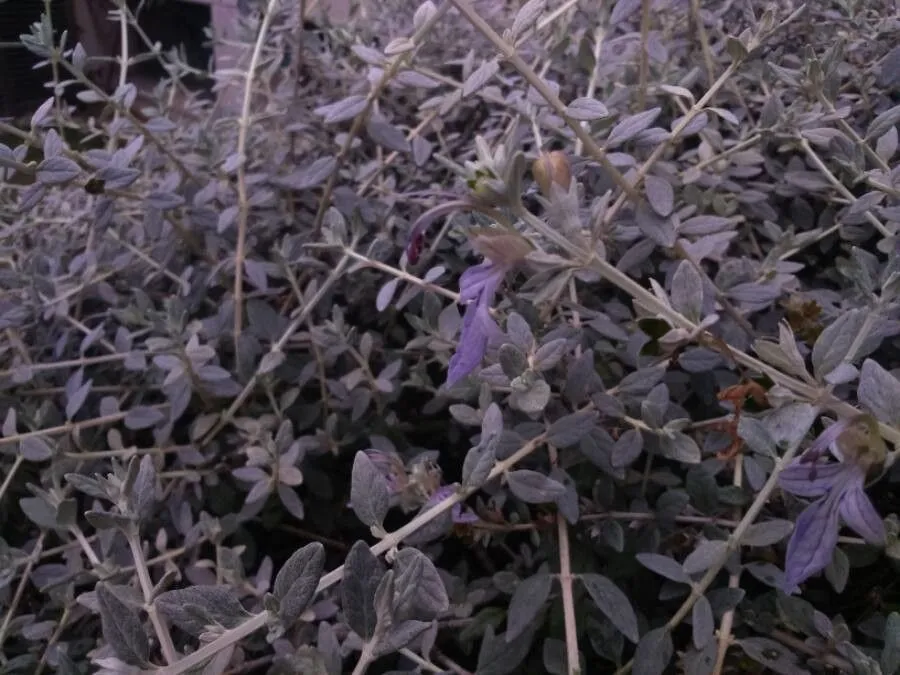
Author: L.
Bibliography: Sp. Pl.: 563 (1753)
Year: 1753
Status: accepted
Rank: species
Genus: Teucrium
Vegetable: False
Observations: W. & C. Medit.
Shrubby Germander, scientifically known as Teucrium fruticans, is a perennial, evergreen shrub that belongs to the Lamiaceae family. This hardy plant is native to the western and central Mediterranean regions, where it thrives in a variety of conditions, showcasing its adaptability and resilience.
A defining feature of the Shrubby Germander is its dense, bushy growth habit. It typically reaches heights and spreads of around 3-4 feet, making it an excellent choice for hedges, borders, and ground cover in gardens. The foliage of Teucrium fruticans is particularly attractive, consisting of small, ovate leaves with a silvery-green hue that adds a unique color and texture to the landscape. These leaves are aromatic, releasing a pleasant scent when crushed.
The flowers of the Shrubby Germander are another highlight, featuring delicate, pale blue to lavender blooms that appear in clusters along the stems. These blooms are known to attract various pollinators, including bees and butterflies, making the plant not only visually appealing but also beneficial for supporting local ecosystems.
Teucrium fruticans is appreciated by gardeners for its low maintenance requirements and drought tolerance. It prefers well-drained soil and can thrive in full sun to partial shade, although it flowers more profusely when exposed to ample sunlight. Once established, this plant requires minimal watering, making it an excellent option for xeriscaping and Mediterranean-style gardens.
Beyond its ornamental value, the Shrubby Germander has been historically noted for its potential medicinal uses. Though not widely studied in modern times, it was traditionally employed in various remedies, a testament to its long-standing presence and utility in Mediterranean regions.
First described in 1753 by the renowned botanist Carl Linnaeus in his landmark publication “Species Plantarum,” Teucrium fruticans stands as a testament to the diversity and enduring appeal of Mediterranean flora. Its combination of aesthetic beauty, hardiness, and minimal care needs makes it a favored choice among gardeners looking to add a touch of Mediterranean charm to their outdoor spaces.
Eng: shrubby germander, tree germander
En: Shrubby germander, Tree germander, Silver Germander
Ar: قطلم
Ca: Teucri fruticós
Zh: 银石蚕
Cs: Ožanka křovitá
Fr: Germandrée arbustive
De: Baum-Gamander, Baumgamander, Silbergamander
It: Camedrio femmina, Fior d’api, Rosmarinone
Es: Salvia amarga, Olivilla, Teucrio
Zh-tw: 銀石蚕
Taken Mar 18, 2019 by Creu Lopez (cc-by-sa)
Taken Mar 18, 2019 by Creu Lopez (cc-by-sa)
Taken Mar 18, 2019 by Creu Lopez (cc-by-sa)
Taken Mar 18, 2019 by Creu Lopez (cc-by-sa)
Taken Mar 18, 2019 by Creu Lopez (cc-by-sa)
Taken Jan 9, 2022 by jean-jacques kelner (cc-by-sa)
Taken Jan 14, 2022 by hieracium eriophorum (cc-by-sa)
Taken Mar 16, 2022 by Dan Castello (cc-by-sa)
Taken Jan 31, 2022 by Monteiro Henrique (cc-by-sa)
Taken Sep 29, 2017 by García Faustino (cc-by-sa)
Taken Jan 31, 2022 by Monteiro Henrique (cc-by-sa)
Taken Mar 16, 2022 by Dan Castello (cc-by-sa)
Taken Dec 14, 2018 by Manu Pacha (cc-by-sa)
Taken Mar 29, 2018 by 1 (cc-by-sa)
Taken Jul 17, 2021 by Sevillano Manuel (cc-by-sa)
Taken Mar 9, 2020 by Ortega Alejandro (cc-by-sa)
Taken Mar 6, 2015 by Tela Botanica − Liliane Roubaudi (cc-by-sa)
Taken Mar 6, 2015 by Tela Botanica − Liliane Roubaudi (cc-by-sa)
Taken Mar 6, 2015 by Tela Botanica − Liliane Roubaudi (cc-by-sa)
Taken Mar 6, 2015 by Tela Botanica − Liliane Roubaudi (cc-by-sa)
Taken Dec 6, 2020 by Pogon Ophio (cc-by-sa)
Taken Mar 22, 2016 by jmn (cc-by-sa)
Taken Mar 7, 2022 by rhamssa kerdouci (cc-by-sa)
Taken Feb 8, 2020 by robin niel (cc-by-sa)
Taken Dec 17, 2021 by alzas gabasa (cc-by-sa)
Taken May 17, 2022 by Lise Saint-Arroman (cc-by-sa)
Taken Oct 8, 2022 by murales (cc-by-sa)
Taken Oct 21, 2022 by jeremie fremont (cc-by-sa)
Taken Oct 21, 2022 by jeremie fremont (cc-by-sa)
Taken Apr 13, 2021 by Eduardo Siquier Cortés (cc-by-sa)
© copyright of the Board of Trustees of the Royal Botanic Gardens, Kew.
© copyright of the Board of Trustees of the Royal Botanic Gardens, Kew.
© copyright of the Board of Trustees of the Royal Botanic Gardens, Kew.
Growth habit: Shrub
Ph maximum: 5.5
Ph minimum: 5.0
Light: 8
Atmospheric humidity: 4
Soil nutriments: 3
Family: Myrtaceae Author: (F.Muell.) K.D.Hill & L.A.S.Johnson Bibliography: Telopea 6: 402 (1995) Year: 1995 Status:…
Family: Rubiaceae Author: Pierre ex A.Froehner Bibliography: Notizbl. Bot. Gart. Berlin-Dahlem 1: 237 (1897) Year:…
Family: Sapindaceae Author: Koidz. Bibliography: J. Coll. Sci. Imp. Univ. Tokyo 32(1): 38 (1911) Year:…
Family: Asteraceae Author: A.Gray Bibliography: Pacif. Railr. Rep.: 107 (1857) Year: 1857 Status: accepted Rank:…
Family: Fabaceae Author: Medik. Bibliography: Vorles. Churpfälz. Phys.-Ökon. Ges. 2: 398 (1787) Year: 1787 Status:…
Family: Aspleniaceae Author: (Cav.) Alston Bibliography: Bull. Misc. Inform. Kew 1932: 309 (1932) Year: 1932…